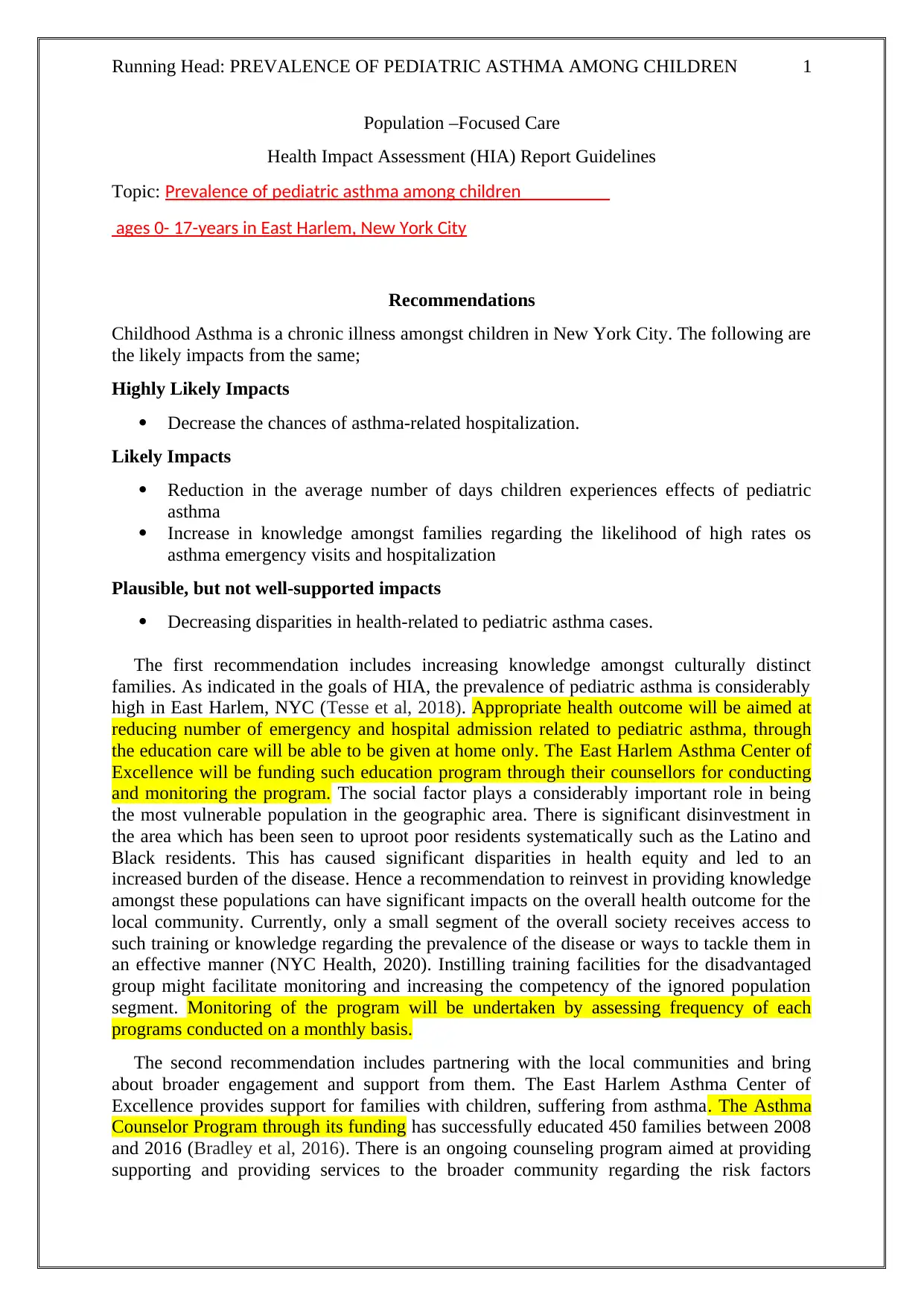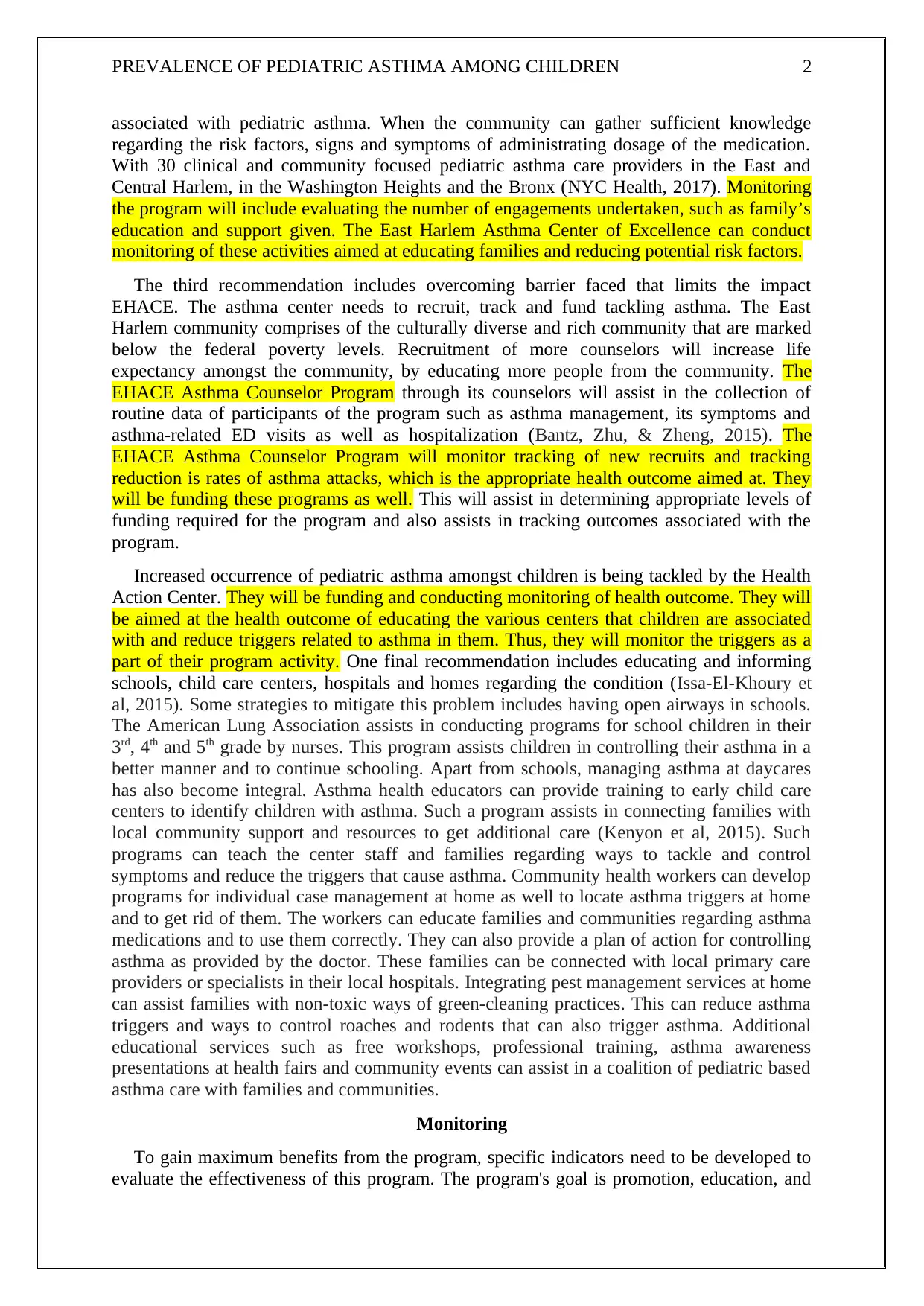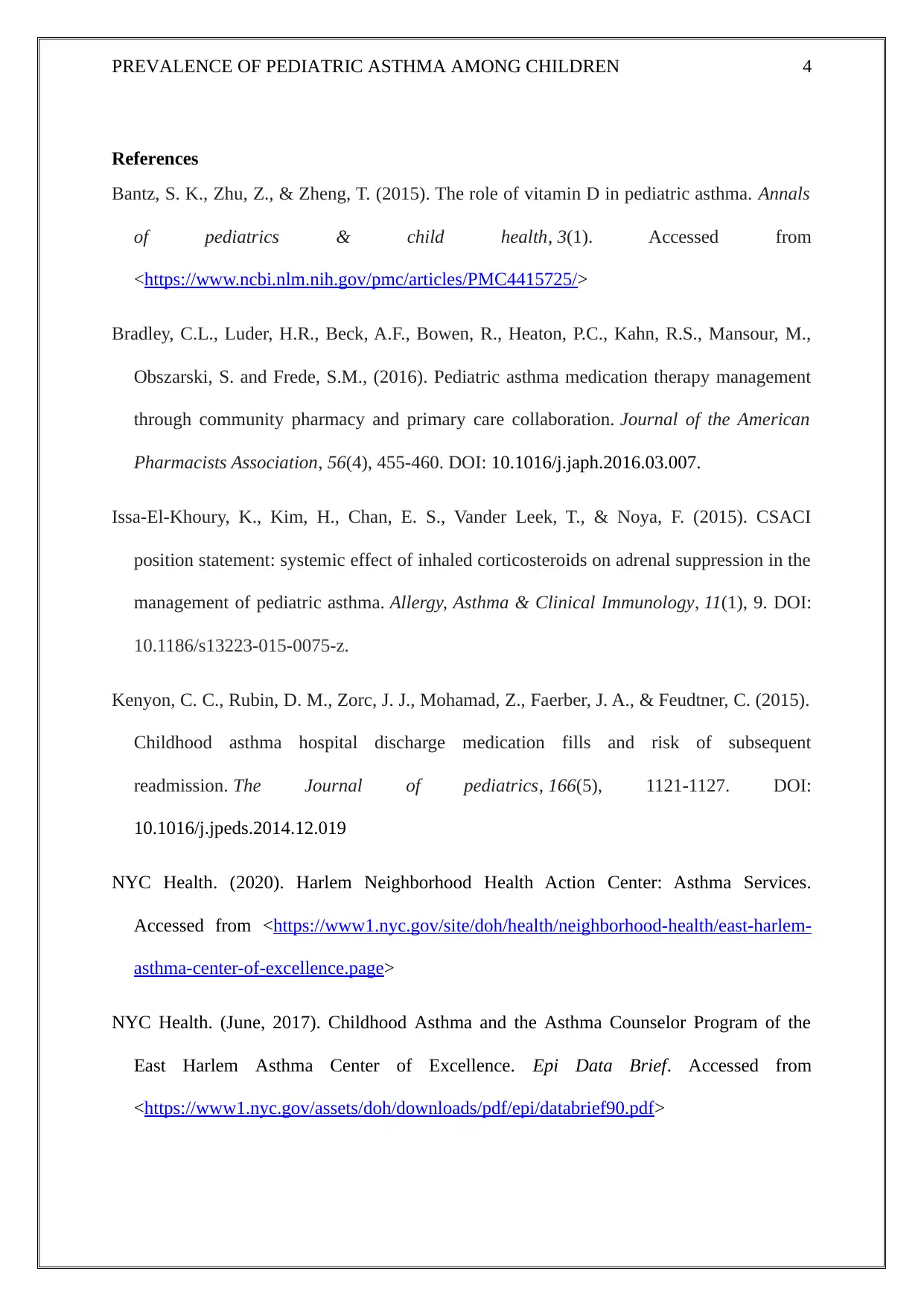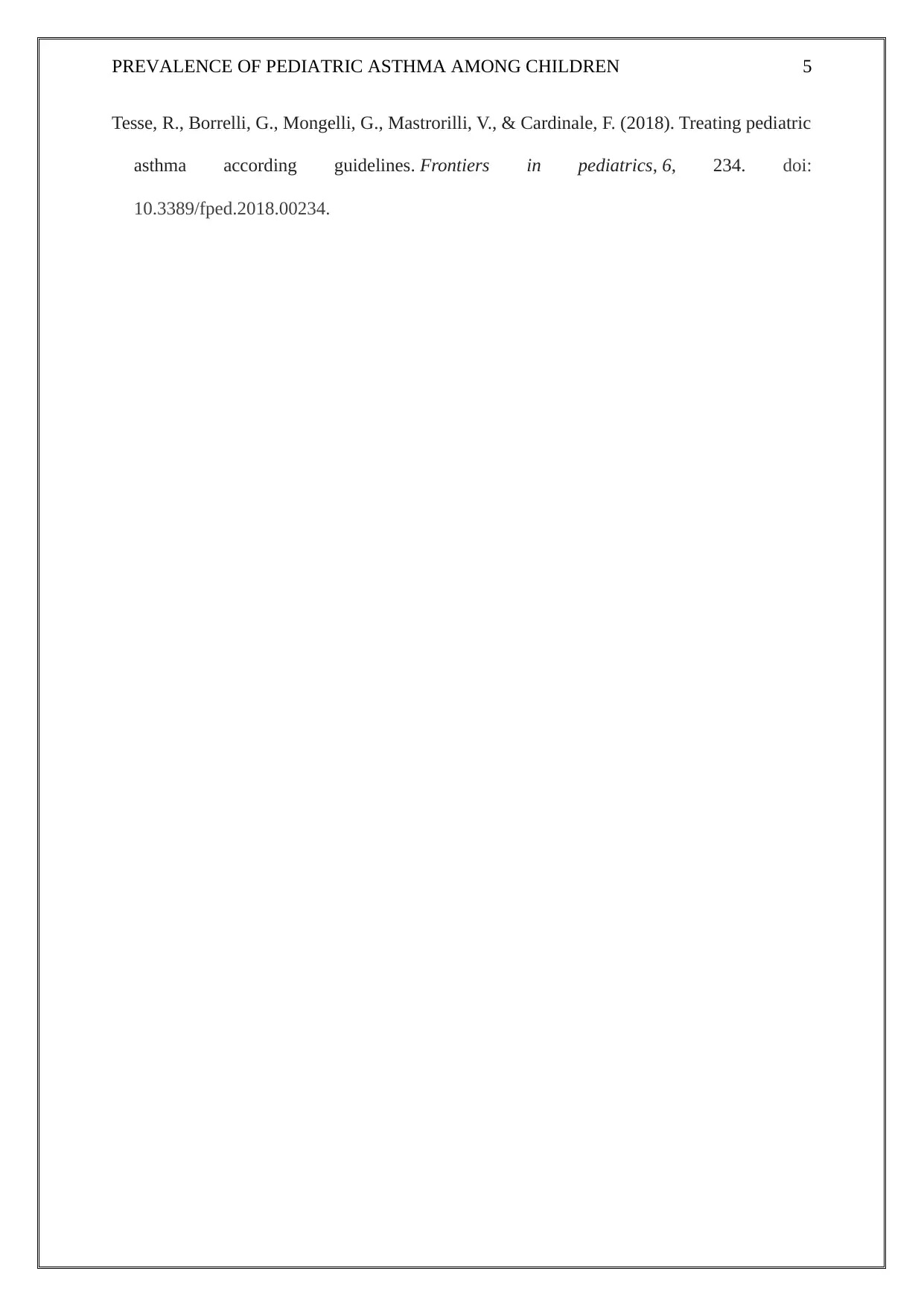Population-Focused Asthma HIA Report: East Harlem, NYC
VerifiedAdded on 2022/08/27
|5
|1666
|14
Report
AI Summary
This report presents a Health Impact Assessment (HIA) on the prevalence of pediatric asthma among children aged 0-17 in East Harlem, New York City. It offers recommendations to reduce asthma-related hospitalizations and improve knowledge among families, including culturally distinct groups. The recommendations include increasing knowledge amongst culturally distinct families, partnering with local communities, overcoming barriers faced by the EHACE, and educating schools and childcare centers. The report also details a monitoring plan, outlining specific indicators for evaluating program effectiveness, including data collection methods, frequency, and responsible parties such as the East Harlem Asthma Center of Excellence and the Harlem Neighborhood Health Action Center. The goal is to promote education and distribution of resources within the community to reduce asthma emergencies and hospital admissions.

Running Head: PREVALENCE OF PEDIATRIC ASTHMA AMONG CHILDREN 1
Population –Focused Care
Health Impact Assessment (HIA) Report Guidelines
Topic: Prevalence of pediatric asthma among children
ages 0- 17-years in East Harlem, New York City
Recommendations
Childhood Asthma is a chronic illness amongst children in New York City. The following are
the likely impacts from the same;
Highly Likely Impacts
Decrease the chances of asthma-related hospitalization.
Likely Impacts
Reduction in the average number of days children experiences effects of pediatric
asthma
Increase in knowledge amongst families regarding the likelihood of high rates os
asthma emergency visits and hospitalization
Plausible, but not well-supported impacts
Decreasing disparities in health-related to pediatric asthma cases.
The first recommendation includes increasing knowledge amongst culturally distinct
families. As indicated in the goals of HIA, the prevalence of pediatric asthma is considerably
high in East Harlem, NYC (Tesse et al, 2018). Appropriate health outcome will be aimed at
reducing number of emergency and hospital admission related to pediatric asthma, through
the education care will be able to be given at home only. The East Harlem Asthma Center of
Excellence will be funding such education program through their counsellors for conducting
and monitoring the program. The social factor plays a considerably important role in being
the most vulnerable population in the geographic area. There is significant disinvestment in
the area which has been seen to uproot poor residents systematically such as the Latino and
Black residents. This has caused significant disparities in health equity and led to an
increased burden of the disease. Hence a recommendation to reinvest in providing knowledge
amongst these populations can have significant impacts on the overall health outcome for the
local community. Currently, only a small segment of the overall society receives access to
such training or knowledge regarding the prevalence of the disease or ways to tackle them in
an effective manner (NYC Health, 2020). Instilling training facilities for the disadvantaged
group might facilitate monitoring and increasing the competency of the ignored population
segment. Monitoring of the program will be undertaken by assessing frequency of each
programs conducted on a monthly basis.
The second recommendation includes partnering with the local communities and bring
about broader engagement and support from them. The East Harlem Asthma Center of
Excellence provides support for families with children, suffering from asthma. The Asthma
Counselor Program through its funding has successfully educated 450 families between 2008
and 2016 (Bradley et al, 2016). There is an ongoing counseling program aimed at providing
supporting and providing services to the broader community regarding the risk factors
Population –Focused Care
Health Impact Assessment (HIA) Report Guidelines
Topic: Prevalence of pediatric asthma among children
ages 0- 17-years in East Harlem, New York City
Recommendations
Childhood Asthma is a chronic illness amongst children in New York City. The following are
the likely impacts from the same;
Highly Likely Impacts
Decrease the chances of asthma-related hospitalization.
Likely Impacts
Reduction in the average number of days children experiences effects of pediatric
asthma
Increase in knowledge amongst families regarding the likelihood of high rates os
asthma emergency visits and hospitalization
Plausible, but not well-supported impacts
Decreasing disparities in health-related to pediatric asthma cases.
The first recommendation includes increasing knowledge amongst culturally distinct
families. As indicated in the goals of HIA, the prevalence of pediatric asthma is considerably
high in East Harlem, NYC (Tesse et al, 2018). Appropriate health outcome will be aimed at
reducing number of emergency and hospital admission related to pediatric asthma, through
the education care will be able to be given at home only. The East Harlem Asthma Center of
Excellence will be funding such education program through their counsellors for conducting
and monitoring the program. The social factor plays a considerably important role in being
the most vulnerable population in the geographic area. There is significant disinvestment in
the area which has been seen to uproot poor residents systematically such as the Latino and
Black residents. This has caused significant disparities in health equity and led to an
increased burden of the disease. Hence a recommendation to reinvest in providing knowledge
amongst these populations can have significant impacts on the overall health outcome for the
local community. Currently, only a small segment of the overall society receives access to
such training or knowledge regarding the prevalence of the disease or ways to tackle them in
an effective manner (NYC Health, 2020). Instilling training facilities for the disadvantaged
group might facilitate monitoring and increasing the competency of the ignored population
segment. Monitoring of the program will be undertaken by assessing frequency of each
programs conducted on a monthly basis.
The second recommendation includes partnering with the local communities and bring
about broader engagement and support from them. The East Harlem Asthma Center of
Excellence provides support for families with children, suffering from asthma. The Asthma
Counselor Program through its funding has successfully educated 450 families between 2008
and 2016 (Bradley et al, 2016). There is an ongoing counseling program aimed at providing
supporting and providing services to the broader community regarding the risk factors
Paraphrase This Document
Need a fresh take? Get an instant paraphrase of this document with our AI Paraphraser

PREVALENCE OF PEDIATRIC ASTHMA AMONG CHILDREN 2
associated with pediatric asthma. When the community can gather sufficient knowledge
regarding the risk factors, signs and symptoms of administrating dosage of the medication.
With 30 clinical and community focused pediatric asthma care providers in the East and
Central Harlem, in the Washington Heights and the Bronx (NYC Health, 2017). Monitoring
the program will include evaluating the number of engagements undertaken, such as family’s
education and support given. The East Harlem Asthma Center of Excellence can conduct
monitoring of these activities aimed at educating families and reducing potential risk factors.
The third recommendation includes overcoming barrier faced that limits the impact
EHACE. The asthma center needs to recruit, track and fund tackling asthma. The East
Harlem community comprises of the culturally diverse and rich community that are marked
below the federal poverty levels. Recruitment of more counselors will increase life
expectancy amongst the community, by educating more people from the community. The
EHACE Asthma Counselor Program through its counselors will assist in the collection of
routine data of participants of the program such as asthma management, its symptoms and
asthma-related ED visits as well as hospitalization (Bantz, Zhu, & Zheng, 2015). The
EHACE Asthma Counselor Program will monitor tracking of new recruits and tracking
reduction is rates of asthma attacks, which is the appropriate health outcome aimed at. They
will be funding these programs as well. This will assist in determining appropriate levels of
funding required for the program and also assists in tracking outcomes associated with the
program.
Increased occurrence of pediatric asthma amongst children is being tackled by the Health
Action Center. They will be funding and conducting monitoring of health outcome. They will
be aimed at the health outcome of educating the various centers that children are associated
with and reduce triggers related to asthma in them. Thus, they will monitor the triggers as a
part of their program activity. One final recommendation includes educating and informing
schools, child care centers, hospitals and homes regarding the condition (Issa-El-Khoury et
al, 2015). Some strategies to mitigate this problem includes having open airways in schools.
The American Lung Association assists in conducting programs for school children in their
3rd, 4th and 5th grade by nurses. This program assists children in controlling their asthma in a
better manner and to continue schooling. Apart from schools, managing asthma at daycares
has also become integral. Asthma health educators can provide training to early child care
centers to identify children with asthma. Such a program assists in connecting families with
local community support and resources to get additional care (Kenyon et al, 2015). Such
programs can teach the center staff and families regarding ways to tackle and control
symptoms and reduce the triggers that cause asthma. Community health workers can develop
programs for individual case management at home as well to locate asthma triggers at home
and to get rid of them. The workers can educate families and communities regarding asthma
medications and to use them correctly. They can also provide a plan of action for controlling
asthma as provided by the doctor. These families can be connected with local primary care
providers or specialists in their local hospitals. Integrating pest management services at home
can assist families with non-toxic ways of green-cleaning practices. This can reduce asthma
triggers and ways to control roaches and rodents that can also trigger asthma. Additional
educational services such as free workshops, professional training, asthma awareness
presentations at health fairs and community events can assist in a coalition of pediatric based
asthma care with families and communities.
Monitoring
To gain maximum benefits from the program, specific indicators need to be developed to
evaluate the effectiveness of this program. The program's goal is promotion, education, and
associated with pediatric asthma. When the community can gather sufficient knowledge
regarding the risk factors, signs and symptoms of administrating dosage of the medication.
With 30 clinical and community focused pediatric asthma care providers in the East and
Central Harlem, in the Washington Heights and the Bronx (NYC Health, 2017). Monitoring
the program will include evaluating the number of engagements undertaken, such as family’s
education and support given. The East Harlem Asthma Center of Excellence can conduct
monitoring of these activities aimed at educating families and reducing potential risk factors.
The third recommendation includes overcoming barrier faced that limits the impact
EHACE. The asthma center needs to recruit, track and fund tackling asthma. The East
Harlem community comprises of the culturally diverse and rich community that are marked
below the federal poverty levels. Recruitment of more counselors will increase life
expectancy amongst the community, by educating more people from the community. The
EHACE Asthma Counselor Program through its counselors will assist in the collection of
routine data of participants of the program such as asthma management, its symptoms and
asthma-related ED visits as well as hospitalization (Bantz, Zhu, & Zheng, 2015). The
EHACE Asthma Counselor Program will monitor tracking of new recruits and tracking
reduction is rates of asthma attacks, which is the appropriate health outcome aimed at. They
will be funding these programs as well. This will assist in determining appropriate levels of
funding required for the program and also assists in tracking outcomes associated with the
program.
Increased occurrence of pediatric asthma amongst children is being tackled by the Health
Action Center. They will be funding and conducting monitoring of health outcome. They will
be aimed at the health outcome of educating the various centers that children are associated
with and reduce triggers related to asthma in them. Thus, they will monitor the triggers as a
part of their program activity. One final recommendation includes educating and informing
schools, child care centers, hospitals and homes regarding the condition (Issa-El-Khoury et
al, 2015). Some strategies to mitigate this problem includes having open airways in schools.
The American Lung Association assists in conducting programs for school children in their
3rd, 4th and 5th grade by nurses. This program assists children in controlling their asthma in a
better manner and to continue schooling. Apart from schools, managing asthma at daycares
has also become integral. Asthma health educators can provide training to early child care
centers to identify children with asthma. Such a program assists in connecting families with
local community support and resources to get additional care (Kenyon et al, 2015). Such
programs can teach the center staff and families regarding ways to tackle and control
symptoms and reduce the triggers that cause asthma. Community health workers can develop
programs for individual case management at home as well to locate asthma triggers at home
and to get rid of them. The workers can educate families and communities regarding asthma
medications and to use them correctly. They can also provide a plan of action for controlling
asthma as provided by the doctor. These families can be connected with local primary care
providers or specialists in their local hospitals. Integrating pest management services at home
can assist families with non-toxic ways of green-cleaning practices. This can reduce asthma
triggers and ways to control roaches and rodents that can also trigger asthma. Additional
educational services such as free workshops, professional training, asthma awareness
presentations at health fairs and community events can assist in a coalition of pediatric based
asthma care with families and communities.
Monitoring
To gain maximum benefits from the program, specific indicators need to be developed to
evaluate the effectiveness of this program. The program's goal is promotion, education, and

PREVALENCE OF PEDIATRIC ASTHMA AMONG CHILDREN 3
distribution amongst the local community. The table below includes a comprehensive
summary of the program outcomes developed on the monitoring criteria for the targeted
population such that they can receive maximum benefits from the program and reduce the
increased incidence of emergencies and hospital admission related to pediatric asthma.
Details of Monitoring
By Whom When How Methods for
reporting findings
East Harlem Asthma
Center of Excellence
Regular and
continuous
Detecting the
number of asthmas
affecting children in
the community
Number of asthma
detection kits
ordered
Counselor of East
Harlem Asthma
Center of Excellence
Once Monthly Educational
programs in schools,
child care centers,
hospitals, and homes
Data collected by
counselors by
counting educational
outreach amongst
community
participants
Harlem
Neighbourhood
Health Action
Center: Asthma
Services
Bi-weekly Counseling families Data collected
amongst families
with children aged
17 years and
younger living in
East and Central
Harlem
Harlem Asthma
Network
Monthly Community-Based
Organization/ Health
Care Providing
EpiData Brief can
provide crucial data
regarding Asthma
Medication
Administration and
Asthma Action Plan
distribution amongst the local community. The table below includes a comprehensive
summary of the program outcomes developed on the monitoring criteria for the targeted
population such that they can receive maximum benefits from the program and reduce the
increased incidence of emergencies and hospital admission related to pediatric asthma.
Details of Monitoring
By Whom When How Methods for
reporting findings
East Harlem Asthma
Center of Excellence
Regular and
continuous
Detecting the
number of asthmas
affecting children in
the community
Number of asthma
detection kits
ordered
Counselor of East
Harlem Asthma
Center of Excellence
Once Monthly Educational
programs in schools,
child care centers,
hospitals, and homes
Data collected by
counselors by
counting educational
outreach amongst
community
participants
Harlem
Neighbourhood
Health Action
Center: Asthma
Services
Bi-weekly Counseling families Data collected
amongst families
with children aged
17 years and
younger living in
East and Central
Harlem
Harlem Asthma
Network
Monthly Community-Based
Organization/ Health
Care Providing
EpiData Brief can
provide crucial data
regarding Asthma
Medication
Administration and
Asthma Action Plan
⊘ This is a preview!⊘
Do you want full access?
Subscribe today to unlock all pages.

Trusted by 1+ million students worldwide

PREVALENCE OF PEDIATRIC ASTHMA AMONG CHILDREN 4
References
Bantz, S. K., Zhu, Z., & Zheng, T. (2015). The role of vitamin D in pediatric asthma. Annals
of pediatrics & child health, 3(1). Accessed from
<https://www.ncbi.nlm.nih.gov/pmc/articles/PMC4415725/>
Bradley, C.L., Luder, H.R., Beck, A.F., Bowen, R., Heaton, P.C., Kahn, R.S., Mansour, M.,
Obszarski, S. and Frede, S.M., (2016). Pediatric asthma medication therapy management
through community pharmacy and primary care collaboration. Journal of the American
Pharmacists Association, 56(4), 455-460. DOI: 10.1016/j.japh.2016.03.007.
Issa-El-Khoury, K., Kim, H., Chan, E. S., Vander Leek, T., & Noya, F. (2015). CSACI
position statement: systemic effect of inhaled corticosteroids on adrenal suppression in the
management of pediatric asthma. Allergy, Asthma & Clinical Immunology, 11(1), 9. DOI:
10.1186/s13223-015-0075-z.
Kenyon, C. C., Rubin, D. M., Zorc, J. J., Mohamad, Z., Faerber, J. A., & Feudtner, C. (2015).
Childhood asthma hospital discharge medication fills and risk of subsequent
readmission. The Journal of pediatrics, 166(5), 1121-1127. DOI:
10.1016/j.jpeds.2014.12.019
NYC Health. (2020). Harlem Neighborhood Health Action Center: Asthma Services.
Accessed from <https://www1.nyc.gov/site/doh/health/neighborhood-health/east-harlem-
asthma-center-of-excellence.page>
NYC Health. (June, 2017). Childhood Asthma and the Asthma Counselor Program of the
East Harlem Asthma Center of Excellence. Epi Data Brief. Accessed from
<https://www1.nyc.gov/assets/doh/downloads/pdf/epi/databrief90.pdf>
References
Bantz, S. K., Zhu, Z., & Zheng, T. (2015). The role of vitamin D in pediatric asthma. Annals
of pediatrics & child health, 3(1). Accessed from
<https://www.ncbi.nlm.nih.gov/pmc/articles/PMC4415725/>
Bradley, C.L., Luder, H.R., Beck, A.F., Bowen, R., Heaton, P.C., Kahn, R.S., Mansour, M.,
Obszarski, S. and Frede, S.M., (2016). Pediatric asthma medication therapy management
through community pharmacy and primary care collaboration. Journal of the American
Pharmacists Association, 56(4), 455-460. DOI: 10.1016/j.japh.2016.03.007.
Issa-El-Khoury, K., Kim, H., Chan, E. S., Vander Leek, T., & Noya, F. (2015). CSACI
position statement: systemic effect of inhaled corticosteroids on adrenal suppression in the
management of pediatric asthma. Allergy, Asthma & Clinical Immunology, 11(1), 9. DOI:
10.1186/s13223-015-0075-z.
Kenyon, C. C., Rubin, D. M., Zorc, J. J., Mohamad, Z., Faerber, J. A., & Feudtner, C. (2015).
Childhood asthma hospital discharge medication fills and risk of subsequent
readmission. The Journal of pediatrics, 166(5), 1121-1127. DOI:
10.1016/j.jpeds.2014.12.019
NYC Health. (2020). Harlem Neighborhood Health Action Center: Asthma Services.
Accessed from <https://www1.nyc.gov/site/doh/health/neighborhood-health/east-harlem-
asthma-center-of-excellence.page>
NYC Health. (June, 2017). Childhood Asthma and the Asthma Counselor Program of the
East Harlem Asthma Center of Excellence. Epi Data Brief. Accessed from
<https://www1.nyc.gov/assets/doh/downloads/pdf/epi/databrief90.pdf>
Paraphrase This Document
Need a fresh take? Get an instant paraphrase of this document with our AI Paraphraser

PREVALENCE OF PEDIATRIC ASTHMA AMONG CHILDREN 5
Tesse, R., Borrelli, G., Mongelli, G., Mastrorilli, V., & Cardinale, F. (2018). Treating pediatric
asthma according guidelines. Frontiers in pediatrics, 6, 234. doi:
10.3389/fped.2018.00234.
Tesse, R., Borrelli, G., Mongelli, G., Mastrorilli, V., & Cardinale, F. (2018). Treating pediatric
asthma according guidelines. Frontiers in pediatrics, 6, 234. doi:
10.3389/fped.2018.00234.
1 out of 5
Related Documents
Your All-in-One AI-Powered Toolkit for Academic Success.
+13062052269
info@desklib.com
Available 24*7 on WhatsApp / Email
![[object Object]](/_next/static/media/star-bottom.7253800d.svg)
Unlock your academic potential
Copyright © 2020–2025 A2Z Services. All Rights Reserved. Developed and managed by ZUCOL.



